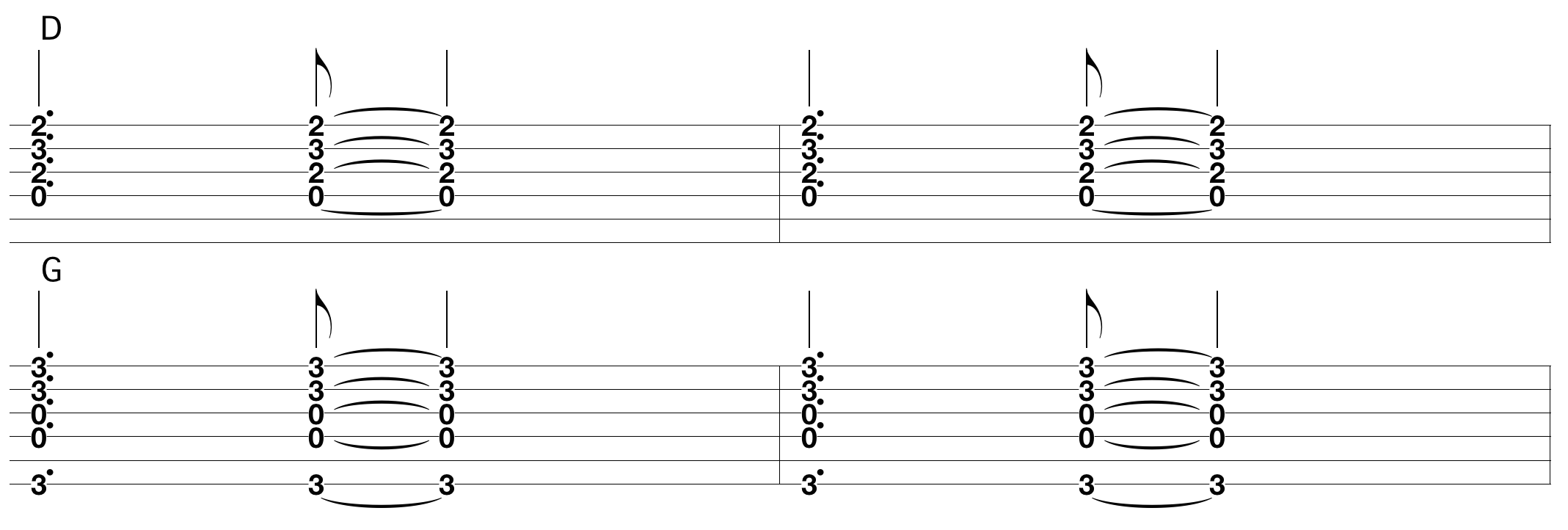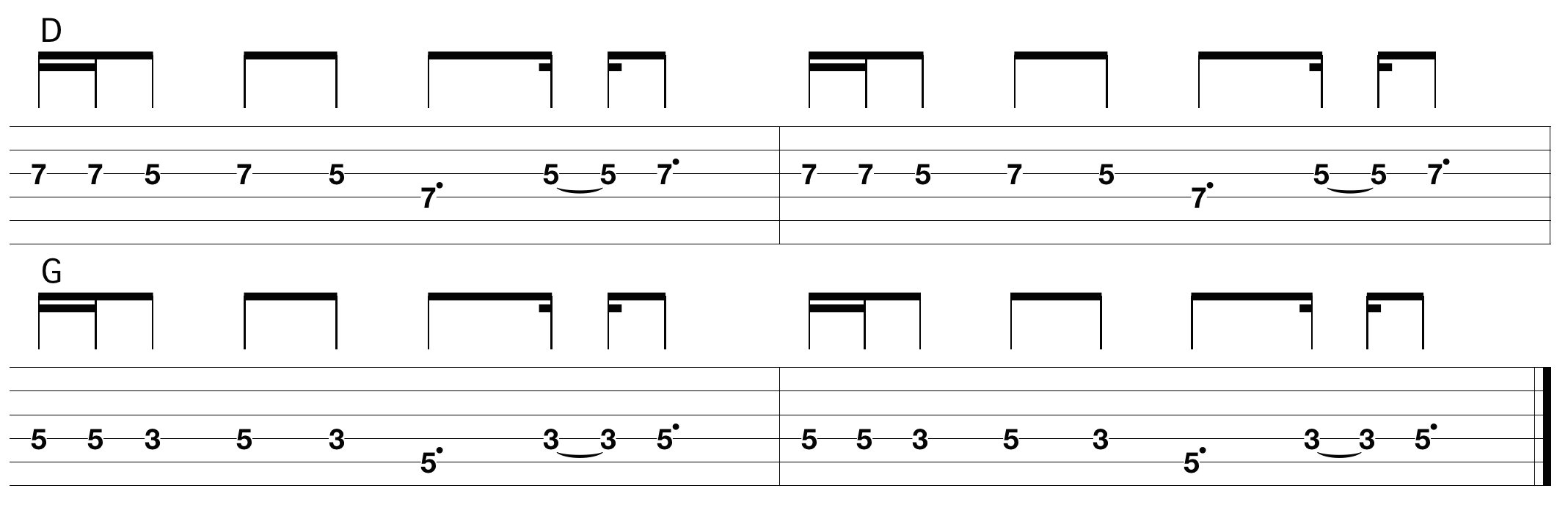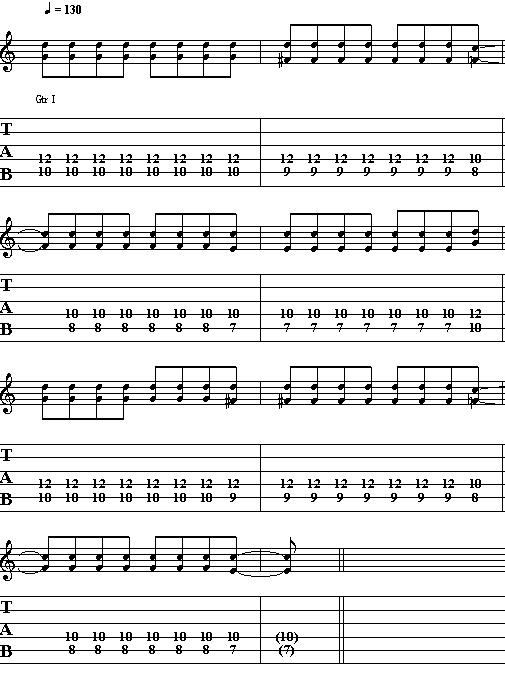Welcome back! My goal for this article is to help you understand the question you and many
other beginners guitar players have been asking “ what is a rhythm guitar ?”.
To define a rhythm guitar we first have to define rhythm. Rhythm is a repeated pattern over a
period of time. For example, we can have a guitar that is not a rhythm guitar but that still has a
rhythm, like the following:
 You can see that I am using the same note values and patterns every bar. I am always starting
with a Dotted Quarter note and then immediately follow it with an Eight note that is tied to a Half
note. I do this in all of the 4 measures. This is rhythm; it is repeated over a period of time. But
still, this is not a rhythm guitar. A rhythm guitar does include a rhythm part, but it’s way more
than that.
When guitar players or any other musician talks about rhythm guitars, they are actually referring
to a different concept. See, a better name for rhythm guitar would actually be “accompaniment
guitar”, why? because that’s what it is. A rhythm guitar is an accompaniment guitar. It is the part
of the song that does not stand out or solo, it is the part that simply accompanies the main
melody, embellishing it and supporting it.
For example, we could use the rhythm of the exercise above and combine it with full chords like
this and it would be a perfect rhythm guitar:
You can see that I am using the same note values and patterns every bar. I am always starting
with a Dotted Quarter note and then immediately follow it with an Eight note that is tied to a Half
note. I do this in all of the 4 measures. This is rhythm; it is repeated over a period of time. But
still, this is not a rhythm guitar. A rhythm guitar does include a rhythm part, but it’s way more
than that.
When guitar players or any other musician talks about rhythm guitars, they are actually referring
to a different concept. See, a better name for rhythm guitar would actually be “accompaniment
guitar”, why? because that’s what it is. A rhythm guitar is an accompaniment guitar. It is the part
of the song that does not stand out or solo, it is the part that simply accompanies the main
melody, embellishing it and supporting it.
For example, we could use the rhythm of the exercise above and combine it with full chords like
this and it would be a perfect rhythm guitar:
 Why is this a perfect rhythm guitar? because it is clearly there to support a melody. It is not
strong enough to provide a melody, thus it is simple enough to support one. For example this
rhythm guitar would go perfectly fine a melody or solo like this:
Why is this a perfect rhythm guitar? because it is clearly there to support a melody. It is not
strong enough to provide a melody, thus it is simple enough to support one. For example this
rhythm guitar would go perfectly fine a melody or solo like this:
 See, a melody on its own could get a bit boring, so we usually add an accompaniment
instrument that provides the harmony (chords) to support the melody and make it more
interesting.
This is all for today. I hope you’ve enjoyed this article and please remember to check out our
entire database of videos.
See, a melody on its own could get a bit boring, so we usually add an accompaniment
instrument that provides the harmony (chords) to support the melody and make it more
interesting.
This is all for today. I hope you’ve enjoyed this article and please remember to check out our
entire database of videos.
 You can see that I am using the same note values and patterns every bar. I am always starting
with a Dotted Quarter note and then immediately follow it with an Eight note that is tied to a Half
note. I do this in all of the 4 measures. This is rhythm; it is repeated over a period of time. But
still, this is not a rhythm guitar. A rhythm guitar does include a rhythm part, but it’s way more
than that.
When guitar players or any other musician talks about rhythm guitars, they are actually referring
to a different concept. See, a better name for rhythm guitar would actually be “accompaniment
guitar”, why? because that’s what it is. A rhythm guitar is an accompaniment guitar. It is the part
of the song that does not stand out or solo, it is the part that simply accompanies the main
melody, embellishing it and supporting it.
For example, we could use the rhythm of the exercise above and combine it with full chords like
this and it would be a perfect rhythm guitar:
You can see that I am using the same note values and patterns every bar. I am always starting
with a Dotted Quarter note and then immediately follow it with an Eight note that is tied to a Half
note. I do this in all of the 4 measures. This is rhythm; it is repeated over a period of time. But
still, this is not a rhythm guitar. A rhythm guitar does include a rhythm part, but it’s way more
than that.
When guitar players or any other musician talks about rhythm guitars, they are actually referring
to a different concept. See, a better name for rhythm guitar would actually be “accompaniment
guitar”, why? because that’s what it is. A rhythm guitar is an accompaniment guitar. It is the part
of the song that does not stand out or solo, it is the part that simply accompanies the main
melody, embellishing it and supporting it.
For example, we could use the rhythm of the exercise above and combine it with full chords like
this and it would be a perfect rhythm guitar:
 Why is this a perfect rhythm guitar? because it is clearly there to support a melody. It is not
strong enough to provide a melody, thus it is simple enough to support one. For example this
rhythm guitar would go perfectly fine a melody or solo like this:
Why is this a perfect rhythm guitar? because it is clearly there to support a melody. It is not
strong enough to provide a melody, thus it is simple enough to support one. For example this
rhythm guitar would go perfectly fine a melody or solo like this:
 See, a melody on its own could get a bit boring, so we usually add an accompaniment
instrument that provides the harmony (chords) to support the melody and make it more
interesting.
This is all for today. I hope you’ve enjoyed this article and please remember to check out our
entire database of videos.
See, a melody on its own could get a bit boring, so we usually add an accompaniment
instrument that provides the harmony (chords) to support the melody and make it more
interesting.
This is all for today. I hope you’ve enjoyed this article and please remember to check out our
entire database of videos.
